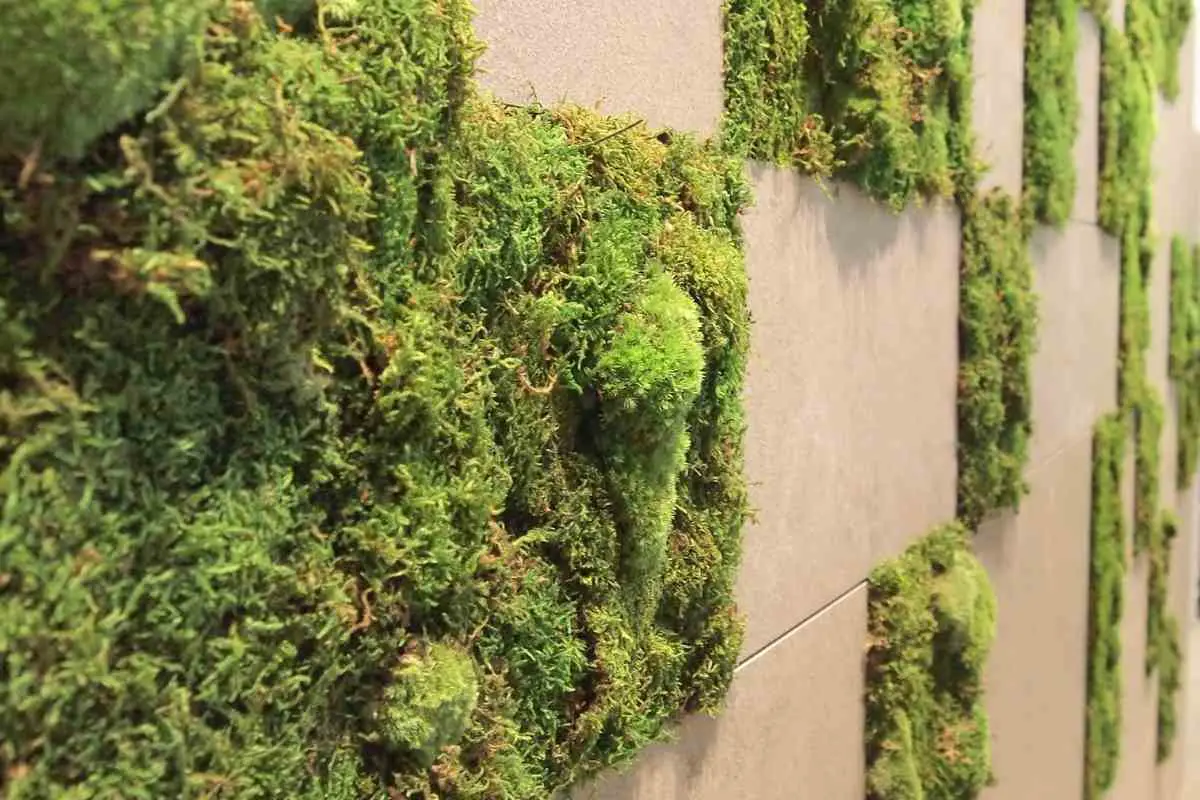Living moss walls make a stunning green addition to your home. Not only are they trendy, but they are also natural air cleansers.
Moss walls make an exquisite and refreshing backdrop for work or business video calls.
Moss is a small green plant that grows in thick clusters. It does not flower and has no roots.
Instead, it hangs onto walls and hard surfaces using tiny hairlike tendrils known as rhizoids.
They are hardy green plants that can thrive in any weather conditions.
If you want this fresh and well-loved look in your home, we have shared pointers and a step-by-step DIY guide to help you make a living moss wall for your home.
Are Living Moss Walls Alive?
Moss walls either contain moss that is alive or preserved moss.
To make a moss wall living depends on the environment they are in and the amount you want to spend.
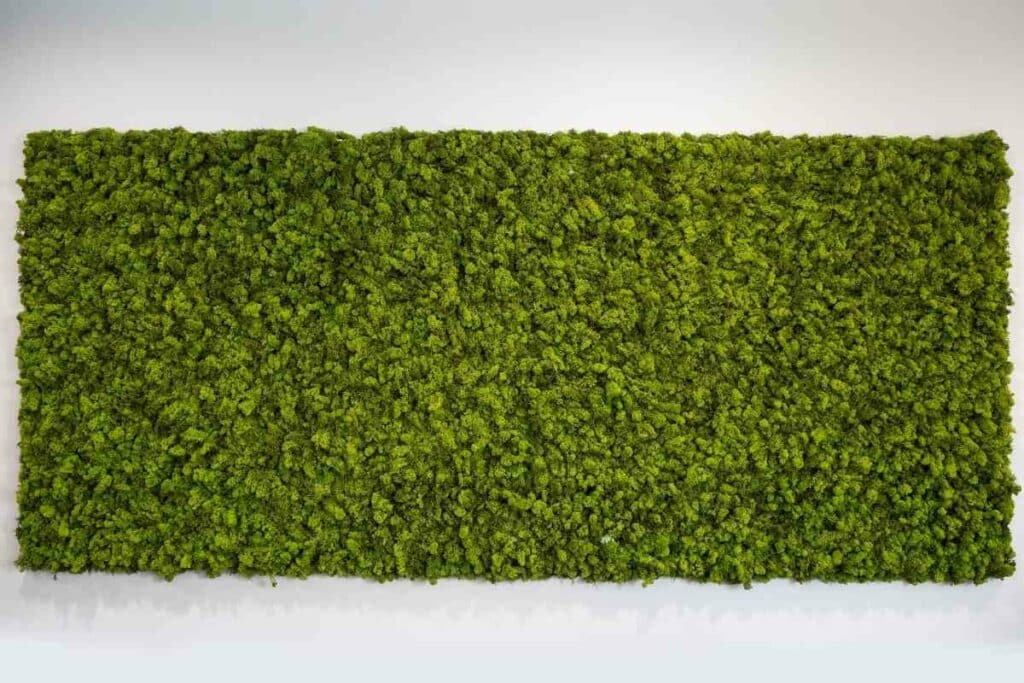
Moss walls that are 100% alive require a lot of maintenance as they need an intricate irrigation system set up or regular moisture to survive.
You do not need to take care of preserved moss as it is set in glycerine to last several decades.
Can You Have A Living Moss Wall Indoors?
Your home decor can use a little greenery with a living moss wall.
You can have an indoor or outdoor living moss wall made from young and growing live moss or dehydrated and preserved moss.
However, live moss grows better outdoors as it can damage the interior walls.
Most indoor living moss walls are not alive. Some may be partly live, but the majority are dead decorative moss.
They are usually coated with glycerin hence the rich green color and ability to last long hanging against the wall.
How Much Do Moss Walls Cost?
Many factors determine the cost of moss walls.
The outline of the moss wall, transport, and installation add up to the final price.
Live moss walls are more expensive to install than preserved moss walls.
Regular maintenance of live moss walls requires a monthly budget.
What to Expect? For every 100 square feet of living space, a live moss wall will cost about $48,000. A similar size preserved moss wall in square footage will cost about $7,000. This figure applies to the installation process only.
Types Of Living Moss Walls
Living moss walls are available in different species and colors, from their appearance, natural habitats to how they grow.
Their colors range from a deep green variety to an almost yellow hue variety.
The common species most people use to make a living moss wall for their homes are:
- Reindeer Moss, Cladonia Rangiferina
- Spanish Moss, Tillandsia Usneoides
- Big Shaggy Moss, Rhytidiadelphus Triquetrous
- Pillow Moss, Leucobyrum Glaucum
- Broom Moss, Dicranium Scoparium
- Sheet Moss, Hypnum Curvifolium
- Fern Moss, Thuidium Delicatum
Reindeer Moss, Cladonia Rangiferina
Reindeer moss is a lichen that grows in both hot and cool climates.
Their appearance is like the antlers on reindeers; thus, the name.
In their natural habitat, they vary in color from green to white.
Most home interior decorators that use reindeer moss prefer to dye it into various vibrant colors for a striking preserved living moss wall.
Spanish Moss, Tillandsia Usneoides
Also known as Long hair Moss, it is native to Florida, Central America, and South America.
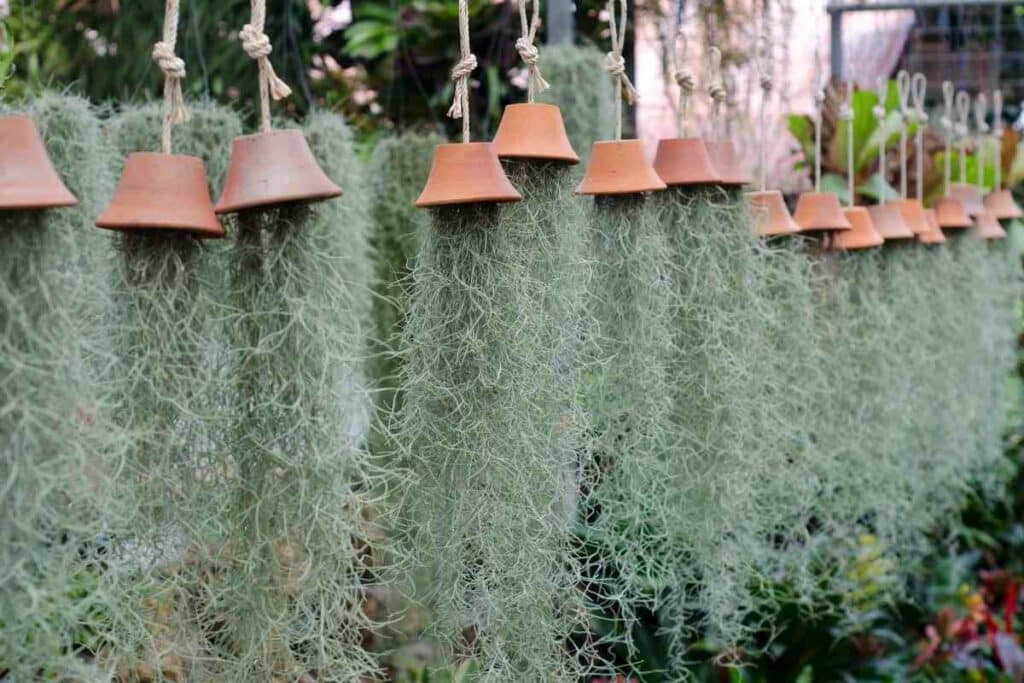
People refer to it as the Spanish beard due to its appearance.
It hangs down from the bark of trees with streaky leaves that have a green-white hue.
It grows best as a hanging display for use as a living moss wall in your home.
Big Shaggy Moss, Rhytidiadelphus Triquetrous
It grows well in rich forests and has a silky appearance.
Its leaves are tiny but long, giving it a fuzzy appearance.
It grows well as an outdoor living moss on bark or wood surfaces in wet soil.
Pillow Moss, Leucobyrum Glaucum
Cushion moss is another name for this variety of living moss.
It has a lush green and white appearance. Pillow moss spreads well if grown outdoors in a live setting.
The clusters are dome-shaped, and they require a good soil base, light, air, and moisture to thrive.
Indoors, it can be grown in pots or containers, with enough room as it tends to grow out.
Broom Moss, Dicranium Scoparium
Popularly known as Mood Moss, it comes from North America.
It also grows in parts of Australia, Asia, and Europe.
Mood moss is sturdy and bristly with shiny green clusters and hairy stems.
Sheet Moss, Hypnum Curvifolium
This variety of green moss grows on a flat rock and soil surface in a carpet-like appearance from the carpet moss family.
It is famous for living moss walls in homes as it spreads out flatly and uniformly.
Fern Moss, Thuidium Delicatum
Fern moss is a widespread moss species native to North and South America.
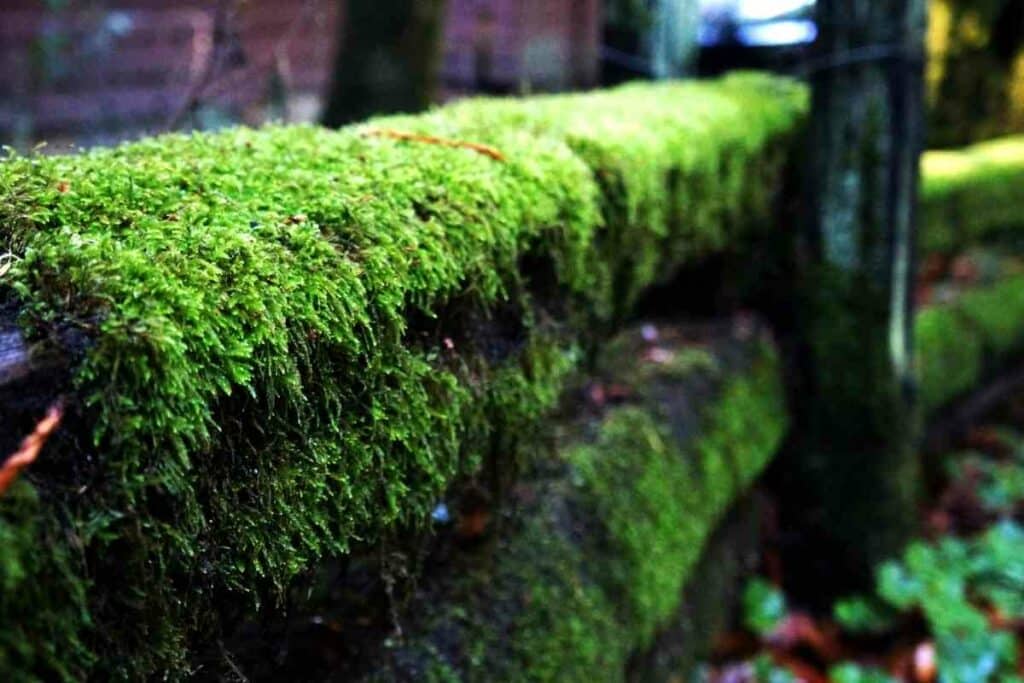
One of the readily available species is mainly dried to make preserved moss.
It has fern-like clumps appearance and spreads widely in live form.
Step-By-Step Guide On How To Make A Living Moss Wall
You can hire an expert from your local moss wall designers and installers to set up one for your home.
However, if you are up to the task and would like to save costs, here is a detailed DIY guide to help you make a living moss wall for your home.
Step 1
Decide what kind of living moss wall you want.
You can choose between:
- a preserved
- maintenance-free
- or a live moss wall
If your living moss wall is for indoor use, we suggest you pick the preserved moss.
For outdoor spaces, choose a live moss set up.
It will require some maintenance, but it will be more beautiful when the plants are outside.
Step 2
Make a frame that you will use to hang your preserved moss.
Depending on your preference, you can make the frame out of wood, metal, or plastic in any shape.
Attach a piece of plywood to the back of your structure where the moss will rest.
For live moss, purchase a wall garden kit. It has a small amount of soil as the moss will require soil and water to grow.
Live walls need a solid wall structure.
Therefore, check with a structural engineer or architect before setting up to ensure your wall can withstand the weight.
Step 3
Pick the variety of living moss plants you want for your home, either alive or preserved.
Local nurseries stock them, and if you cannot find the species you would like, make an online purchase.
Include the dry accessories required for a preserved wall.
These pieces are:
- dry bark
- mushroom sponges
- dry flowers
- ferns
- seed pods
- and twigs
Choose the ideal species of live moss depending on its final planting location.
Step 4
Assemble your preserved moss and begin attaching it to the frame using hot glue.
Arrange the moss and accessories in whichever design you like until the structure is complete.
You can mix different colors of the moss for a striking look.
Be careful when planting them for live moss, as it can be challenging.
If the live moss is to hang on the wall indoors, plant it in the small soil pockets, leaving room for it to grow.
Plant them on rocky ground with a bit of soil or against the outdoor wall space if they are for outdoor use.
Live moss will grow and spread out on its own.
Step 5
To maintain your live moss wall, consider installing a recirculating irrigation system.
It is an automatic watering system with a timer.
You do not have to have a regular water source or water drainage, which makes it an ideal set-up for indoor live walls.
Have a professional do the installation before setting up the live moss wall.
Alternatively – Ensure someone maintains the live moss wall every day. The person will need to water it, prune any excess growth, apply pesticides to prevent bugs and insects, and clean up dead debris frequently.
Preserved moss walls are usually dry and do not require any maintenance.
What Is The Difference Between Live Moss And Preserved Moss?
Live and preserved moss walls bring an eco-friendly and naturally green vibrancy into living and working spaces.
However, these two types of moss are pretty different.
Live Moss
Live moss is a cluster of alive moss plants that require regular watering, sufficient sunlight, and air to grow.
Live moss plants are heavy and spread, requiring strong walls to withstand their weight.
It needs a well-laid irrigation system and regular maintenance for its luxurious green look indoors, which can be expensive.
Keep In Mind – A gardener will need to trim it every few weeks, remove any dead pieces and spray pesticides to prevent bugs from crawling around the live moss wall.
The caretaker will also need to ensure the watering system and lighting conditions work well.
If you can afford the workload a live moss wall requires, it will make an exquisite addition to your living space while cleansing the air.
Preserved Moss
Preserved moss is the complete opposite of live moss.
Since it is dry moss, it does not require regular care or maintenance and is perfect for indoor use.
Preserved moss is in the form of moss that was previously living, now preserved in glycerin to give it the lush green appearance for years.
Living moss is a natural plant, although no longer alive.
You do not have to add soil or water to them, but they should be kept away from direct sunlight for long periods.
Since they are not alive, they will not attract insects or pests. Misting them every few weeks keeps them looking fresh and vibrant.
Their set-up is possible in every shape, color, and size for worry-free maintenance.
Preserved moss decorations are also easy to move around within the home.
These moss walls can last over ten years in your home if they do not have flowers or fern in their arrangement.
Heads Up! Preserved moss does not do well outdoors for long periods. The moisture, direct sunlight, and differing temperature conditions can quickly destroy it.
However, live moss thrives outdoors. The perfect condition for live moss is when they grow on the ground, on rocks, or on dead tree branches.
Living moss makes a great wall in commercial buildings or homes where proper and regular maintenance is readily available.
Can Preserved Moss Wall Come Back Alive?
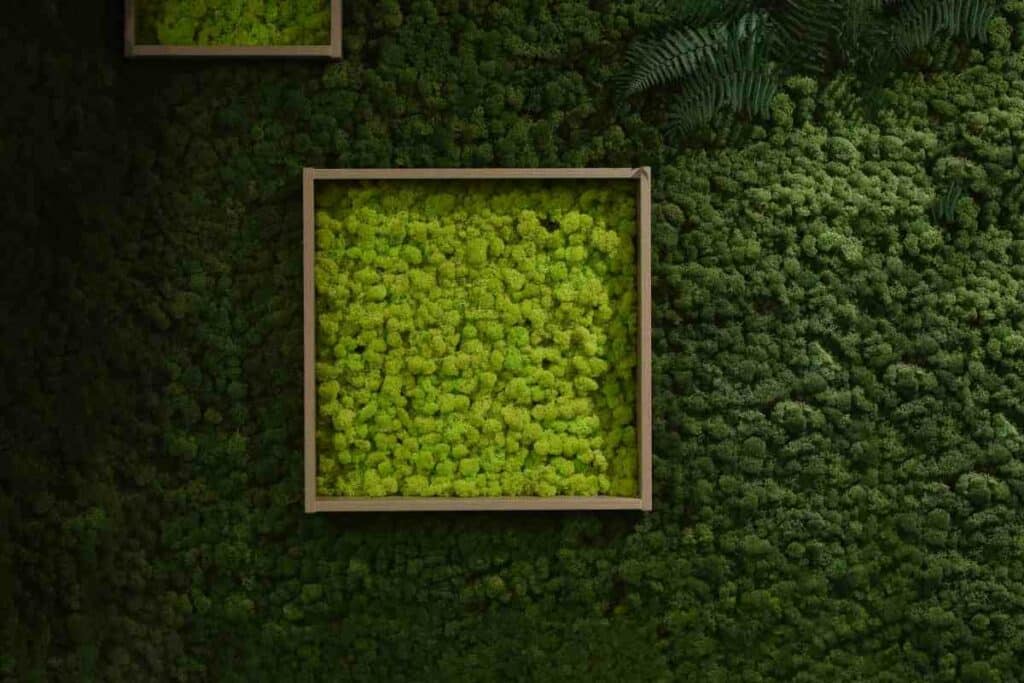
No, preserved moss wall cannot come back alive.
There is no moisture from water in the plant, and glycerin is added to it to keep it looking alive.
The natural properties die out during the preservation process, and they can never come alive again or grow out.
How Long Do Moss Walls Last?
With proper care and maintenance, preserved moss walls can last more than ten years, although they do not need that much attention.
On the other hand, live moss can last for about three years.
Under the right conditions and maintenance, you can extend a live moss wall’s lifespan to about 5-8 years.
Benefits Of Living Moss Walls
Living moss walls have other spectacular benefits besides decorating your home or office space and cleansing the air.
Act as a noise reduction medium
Vegetation, especially trees, is well known to reduce street or external noise coming into buildings.
Living moss walls play the same role in your home or office space.
They will block out any high-frequency sounds for a peaceful indoor ambiance.
It saves on energy costs
Living moss walls cool the area around where they are in the house.
You will save on cooling costs, especially in summer.
They act as insulation barriers keeping your walls warm enough during winter, reducing your heating bill.
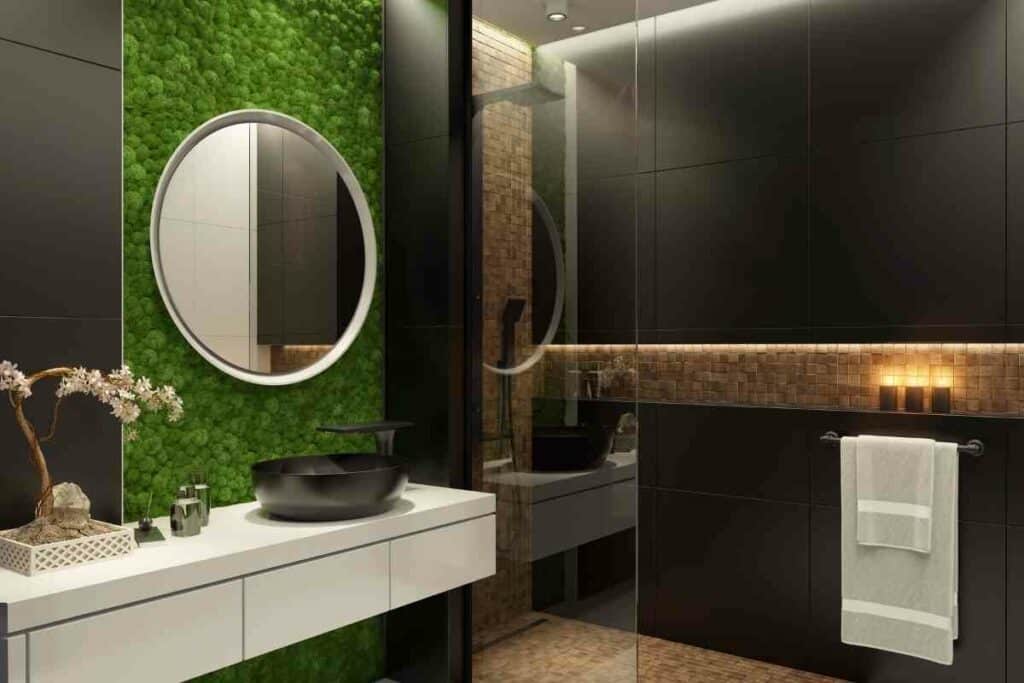
Enhances personal productivity
With a living moss wall in your home, your stress levels are low, and you are attentive to what is happening around you.
Therefore, your level of productivity will improve. People tend to think clearer and produce better results in environments that have plants.
Relieves stress
Plants have a calming effect on people who live or work close to them.
A living moss wall is similar to plants and will help relieve everyday pressures and stresses.
It reduces dust in the air around your home
The air around the home contains harmful pollutants such as:
- bacteria
- mold
- and chemical fumes
These pollutants can cause flare-ups of allergies and other respiratory-related illnesses.
Having a living moss wall in your home will prevent this as it will absorb most of the dust particles floating around in the air.
Absorb excess carbon dioxide from the air
Human beings breathe out carbon dioxide, which is suitable for plants as they absorb it.
We require oxygen which plants expel.
With a living moss wall, this symbiotic relationship is beneficial for everyone in your home.
It promotes healthy skin
Living in a green environment with plants provides moisture, which hydrates your skin.
Dry skin is bad for your health as you will be prone to skin irritation and signs of aging.
Living moss walls in your home will prevent your skin from drying out, which can cause premature wrinkling
Wrapping Up
Use simple tools to make an excellent living moss wall for your home.
You will have a stunning backdrop for your photos, but your visitors will also be in awe of its beauty every time.
You also get to have a better quality of life thanks to living moss walls’ various benefits to your home.
